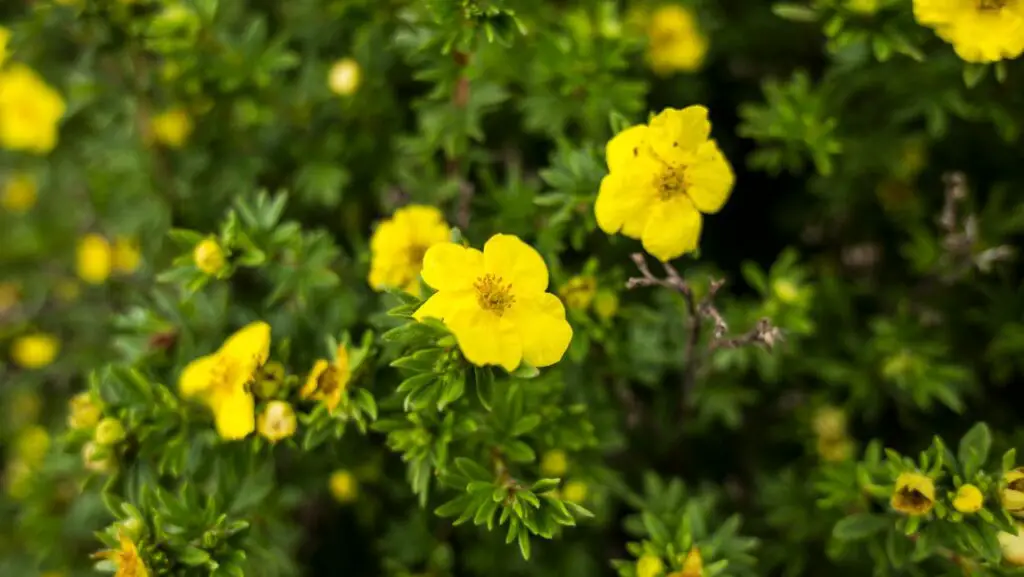
Discreet but essential as a flowering complement, potentillas bring a touch of color to the garden for most of the year. While most varieties bloom yellow, some offer complementary colors.
In this article, I have gathered for you all the information about this plant, its main characteristics and what you need to know to plant and grow it.
Characteristics of the potentilla plant
| Scientific name | Potentilla Fruticosa |
| Family | Rosaceae |
| Origin | Northern Hemisphere |
| Foliage | Deciduous |
| Flowering | June-October |
| Rusticity | -20°C (-68°F) |
| Exposure | Sun or light shade |
| Soil | Normal, even limy |
The shrubby potentillas are low and spread out bushes rarely exceeding 1.50m in height. Their small leaves are not very remarkable; on the other hand, their numerous flowers – which persist from May until the first frost – brighten up the beds.
Most varieties bloom yellow or white but the palette available for sale is enriched every year with orange and pink tones.
How to grow potentilla
These plants grow in all soils, even limestone, with sunny exposure. The shade quickly opposes the flowering.
Watering must be regular, especially in summer, because a prolonged dry period can interrupt any appearance of flowers.
In February, or in winter in mild climates, prune the clumps at ground level to renew all the vegetation.
How to grow potentilla in pot
It is easy and recommended for beginners. In a slightly too-large pot, potentillas can live for several years without repotting. For example, a plant bought in a 3-liter container will be at ease in a 30 to 40 cm diameter pot. A simple commercial potting soil is sufficient, but from the second year onwards you will have to add a fertilizer for flowering shrubs, from March to September or October.
In case of late frosts, protect the plant with a triple layer of winter veil, as the flower buds form quite early.
Where to plant a potentilla shrub
Potentilla is a versatile and easy-to-grow plant that can be used for various applications. Low beds, borders, rock gardens, and pots are ideal locations for planting Potentilla. The plant is drought tolerant and can tolerate a wide range of soil types, making it ideal for a variety of garden settings. For those without a garden, Potentilla can also be grown on balconies and terraces, as long as it has access to plenty of sunlight. Combine several varieties; the choice is vast.
Our selection
Overall, the shrubs are not big. For ground cover, here are two spreading selections:
- ‘Tangerine‘, with tapering growth, l m tall and as much diameter, with orange-yellow flowers.
- ‘Goldteppich‘, 1.20 m in all directions, golden yellow.
In the spreading forms, you can plant:
- ‘Klondike‘, 60 cm high and 1 m in diameter, golden yellow; ‘Elizabeth’, 80 cm high by over 1 m wide, golden yellow
- ‘Red Ace‘, 60 cm in all directions, with vermilion red flowers, for low calcareous soils only.
- ‘Long Acre‘, 50 cm high and 1 m in diameter, with white flowers.
In the rounded forms:
- ‘Princess‘, 80 cm high and 60 cm in diameter, offers pink flowers whose intensity is more important in mid-shade.
- ‘Pretty Polly‘, a small ball of 30cm of soft pink flowers.
For upright figures:
- ‘Goldfinger‘, 4 ft. tall and wide, with many large golden yellow flowers;
- ‘Jackman‘, 4 ft. tall, with abundant small yellow early flowers;
- ‘Abbotswood‘, 80 cm in all directions, for lovers of white flowers.
In a nutshell
The Potentilla plant is a versatile and hardy species of flowering bush that is easy to keep in any sunny outdoor environment. The plants require minimal maintenance and are able to thrive with limited water, providing blooms of beautiful yellow, white, or pink flowers. As an ideal addition to a garden or an outdoor living area, these plants can be enjoyed for many years with very little effort.

Hi!
I am the guy behind Theyardable.com. I grew up on a homestead and I am here to share the knowledge I have and things I learn while living in the countryside.
